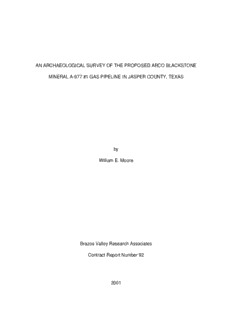
an archaeological survey of the proposed arco blackstone PDF
Preview an archaeological survey of the proposed arco blackstone
AN ARCHAEOLOGICAL SURVEY OF THE PROPOSED ARCO BLACKSTONE MINERAL A-977 #1 GAS PIPELINE IN JASPER COUNTY, TEXAS by William E. Moore Brazos Valley Research Associates Contract Report Number 92 2001 AN ARCHAEOLOGICAL SURVEY OF THE PROPOSED ARCO BLACKSTONE MINERAL A-977 #1 GAS PIPELINE IN JASPER COUNTY, TEXAS BVRA Project Number 01-14 Principal Investigator William E. Moore Prepared by Brazos Valley Research Associates 813 Beck Street Bryan, Texas 77803 Prepared for Environmental and Safety Professionals, Inc. 16022 Highway 165 Kinder, Louisiana 70648 ABSTRACT An archaeological investigation of an 1884 foot pipeline (1.3 acres) in western Jasper County, Texas was performed by Brazos Valley Research Associates (BVRA) of Bryan, Texas in July 2001. No archaeological sites were found to exist within the project area, and it is recommended that construction be allowed to proceed as planned. ii ACKNOWLEDGMENTS I am appreciative of the assistance provided by the following individuals. Ron Fossett of Environmental and Safety Professionals, Inc. in Kinder, Louisiana provided maps and were on site during the survey. The Principal Investigator is grateful to the Project Archaeologist (James E. Warren) and the field crew (Arthur Romine and Bobby Jemison) for their assistance during the survey. William A. Martin at the Texas Historical Commission, Archeology Division, served as the reviewer for this project, and his input was valuable to the successful outcome of this investigation. Adrianne Mraz, Research Assistant, at the Texas Archeological Research Laboratory, assisted the Principal Investigator in the records check of the site records for previously recorded sites in and near the project area. The figures were prepared by Lili Lyddon and Ron Fossett. iii CONTENTS ABSTRACT......................................................................................................................ii ACKNOWLEDGMENTS..................................................................................................iii INTRODUCTION.............................................................................................................1 PROJECT SETTING.......................................................................................................4 ARCHAEOLOGICAL BACKGROUND............................................................................6 METHODS......................................................................................................................8 RESULTS AND RECOMMENDATIONS.......................................................................10 REFERENCES CITED..................................................................................................11 Appendix I: Shovel Test Log Figures Figure 1. General Location Map......................................................................................2 Figure 2. Project Area on Topographic Map Jasper East................................................3 Figure 3. Project Area on Soils Map................................................................................5 Figure 4. Project Area Map Depicting Shovel Test Locations .........................................9 iv INTRODUCTION Duke Energy Field Services, Inc. plans to install a 4" gas pipeline along an 1884 foot route (1.3 acres) in western Jasper County, Texas (Figure 1). The proposed pipeline will connect a gas well that is currently under construction (Station 18+84) to an existing pipeline riser (Station 0+00). The maximum width of the pipeline route will be 30 feet; however, the actual ground disturbance or permanent easement will only affect 10 feet; the remaining 20 feet is a temporary work area. The projected depth along the pipeline route is four feet. The project area is depicted on the 7.5' United States Geological Survey topographical map Jasper East (dated 1984 [Provisional Edition]) (Figure 2). Adrinne Mraz, Research Assistant at the Texas Archeological Research Laboratory (TARL) in Austin, Texas was contacted regarding the presence of previously recorded sites in the project area. After reviewing the Jasper East topographic quadrangle, she stated that no archaeological sites have been recorded at TARL in the project area. There is no evidence that a previous archaeological investigation was done around the well site and along the pipeline route. No sites have been recorded within a 1000 meter parameter of the project area. Overall, the project area is located in a region known to contain significant archaeological sites. Because of this archaeological potential, a survey by professional archaeologists was requested by the Texas Historical Commission. BVRA was retained by Environmental and Safety Professionals, Inc. of Kinder, Louisiana to examine the proposed pipeline route for the presence of significant archaeological sites. The project number assigned by BVRA is 01-14. The field survey was conducted on July 24, 2001. 1 Figure 1. General Location Map 2 Figure 2. Project Area on Topographic Map Jasper East 3 PROJECT SETTING In general, the project area is located in the lower Gulf Coastal Plain (Fenneman 1938) along the Angelina River valley north of the confluence of that river with the Neches River. This area is within the Austroriparian biotic province (Blair 1950). Specifically, the area consists of mature and second growth upland forests composed of loblolly pine, yellow pine, and hardwoods that include various oaks. There are two soil types in the project area according to the soil survey for Jasper County (Neitsch 1982:Sheet 7). These are the Letney-Tehran association, undulating (LTC) (Neitsch 1982:30) and the Tehran-Letney association, hilly (TLE) (Neitsch 1982:43-44). The project area depicted on the soils map appears as Figure 3. LTC soils are deep sandy soils on uplands on broad ridges and side slopes above drainageways. They occupy most of the highest landforms in the survey area. Slopes range from 1 to 8 percent. Letney soils are well drained, and Tehran soils are somewhat excessively drained. Permeability of the soils is moderately rapid, and runoff is slow. The available water capacity is medium for Letney soils and low for Tehran soils. These soils are typically used as woodland. TLE soils are deep sandy soils on ridge tops and side slopes above drainageways on uplands. Slopes range from 8 to 20 percent. Tehran soils are somewhat excessively drained, and Letney soils are well drained. Permeability of Tehran and Letney soils is moderately rapid, and runoff is slow. The available water capacity is low for Tehran soils and medium for Letney soils. The project area is situated in an upland setting at the 356 foot contour (gas riser) and 340 feet (well site). The nearest water outside of the project area consists of a tributary of Sandy Creek approximately 580 meters west of the project area. The nearest permanent streams are Bishop Creek, 2500 meters to the east and Sandy Creek, 2100 meters to the west. 4 Figure 3. Project Area on Soils Map 5
Description: